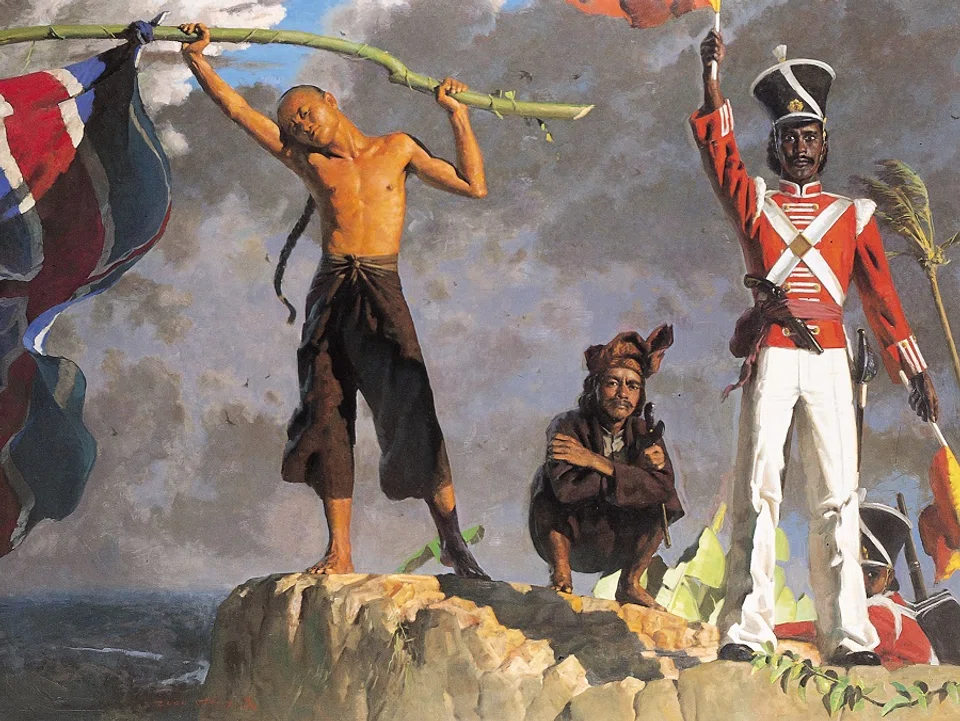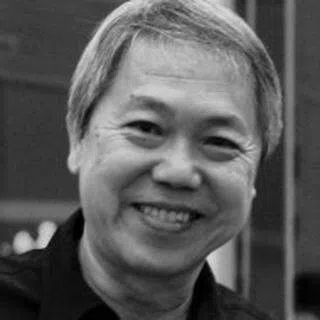A Chinese carpenter and Raffles’ landing in Singapore
Did Cao Yazhi exist? Writer Teo Han Wue ponders the story of a Chinese carpenter who allegedly played a key role in the landing of Sir Stamford Raffles in Singapore.

A Chinese carpenter named Cao Yazhi (曹亚志) played such an important role in Sir Stamford Raffles’ landing in Singapore that he was rewarded with two plots of land on which he founded clan organisations for clansmen arriving from China after him.
So says a dramatic story circulating for decades in the Chinese community here, especially a Cantonese clan association attributing credit to Cao whom they have regarded as their founder even to this day.
Despite being often disputed for lack of verifiable evidence since journalist Hong Jintang discovered the story in 1949, the account as well as the very existence of the protagonist himself has frequently emerged in discussions and even debates, sometimes inspiring articles as well as artworks based on the narrative.
Back in the 1950s, Cao’s story was retold in Chinese textbooks in schools in Malaya and Singapore exemplifying the Chinese contribution to the founding of Singapore. But it may not have been as widely circulated as imagined because most people I have spoken to from that period could not recall having read it during their school days.
A traitor or a hero?
Singapore artist Siew Hock Meng (1942 - ) became curious when he read the story in an old book on the history of Singapore in the 1970s. What Cao Yazhi or Chow Ah Chey, a carpenter on board Raffles’ ship Indiana, is said to have done that led to his being depicted as a heroic figure, revolted him. Shouldn’t Cao have felt ashamed helping the British Empire colonise Singapore, he had wondered. He kept thinking over the question and decided to delve deeper into it and found it a good subject for a painting.

He sought out Hong Jintang to learn more about Hong’s references. After mulling over it for many years he finally completed an oil painting titled The Dawn of an Era in 2000 to express his thoughts about this historic moment.
Measuring 3m x 2m, the painting in oil on canvas is probably the largest Siew had ever done. Obviously the artist placed great importance on this particular piece of work, which had taken him about 20 years to work on. It was first exhibited at the Singapore Art Museum in 2001 before it went into the private collection of Kwee Swie Teng, an Indonesian collector who owns Art Retreat in Ubi Techpark, where I was director of the private museum.
Raffles is completely absent from the picture. Instead the artist imagines a scene presumably through Raffles’ telescope from the ship.
The painting shows three figures on an outcrop on a hill overlooking a wooded area with a river flowing through against a sombre sky. The man on the left is a bare-bodied Chinese in black pants sporting a queue dangling from his tilted head as he held up the Union Jack fastened on a branch from a tree with both hands; on the right is an Indian man in Sepoy uniform sending flag signals gazing sternly and blankly ahead; between them squats a Malay man in traditional attire complete with a tanjak (head band), arms tightly folded across his chest clutching a keris, a symbol of power in Malay culture, in his right hand.
Cao has volunteered to lead a reconnaissance party to go on shore to ascertain the situation. Accompanied by a group of Sepoy soldiers he ventures up the hill that must be where Fort Canning Hill is today. From there he and the Sepoy signal to Raffles and those on board the Indiana that all was clear.
Sentiments at a critical moment
Raffles is completely absent from the picture. Instead the artist imagines a scene presumably through Raffles’ telescope from the ship. Cao’s posture of turning his head sideways as though in shame when waving a partially visible Union Jack is somewhat ambiguous — though he volunteered himself, could he have chosen not to do so? Siew explains he had at first thought Cao should have felt ashamed but later conceded that the lowly Chinese carpenter had little choice given the circumstances.
Siew paints the Indian soldier in Sepoy uniform expressionless, standing stiffly and striking a pose not unlike that of a toy soldier, which perhaps is what the artist intended to hint at. He appears to act dutifully and mechanically by signalling an important message eagerly awaited by Raffles on board the Indiana.

The Malay man in the middle is more conspicuous because he is squatting, his facial expression and body language being almost inscrutable and enigmatic. Why is he squatting down while the other two are standing? What is he thinking? Why is he frowning looking bemused at all the flurry around him as though it has nothing to do with him? He looks on with disinterest adopting a posture commonly seen in a Malay village, ostensibly oblivious to what is going on around him. And yet he seems to be wary of something ominous in all the fuss that the intruders are making as suggested by the tension of his folded arms and keris-clutching hand.
In 2004 Siew Hock Meng held his first ever solo exhibition at Art Retreat. In curating the show, I made The Dawn of an Era the centrepiece among other paintings whose themes dealt mainly with landscape, history and heritage of Asian and Southeast Asian countries such as the spice trade, mythologies, rituals, iconic temples and monuments in India, Indonesia, Cambodia and Myanmar.
The painting proved to be a special highlight that visitors spent much time discussing while viewing it at the exhibition, which was most unusual in my experience.
For his brave act, Chow is said to have been given two plots of land in No. 1 Lavender Street and No.135 South Bridge Road, where the two clan organisations were built in 1819 and 1822 respectively.
Later the painting went with the exhibition to the National Art Museum of China in Beijing where viewers with a completely different background focused more on how good the painting was rather than on the finer points that would engage Singaporeans.
In 2013 the Singapore Federation of Chinese Clan Associations organised a forum entitled “Did Chow Ah Chey Really Exist?” Siew Hock Meng joined the panel to share his thoughts on the story that inspired his painting The Dawn of an Era.

Serious doubts were raised at the forum as to whether Chow Ah Chey (Cho Ah Chee) had any part in the Raffles’ landing in Singapore and if he really existed. It led Mr Lee Tat Cheng, then chairman of Ning Yeung Wui Kuan, who was in the audience to admit that it might be necessary for his clan association to revise their records.
An elusive founder of a Cantonese clan
The records of two clan associations — the House of Cao Clan (曹家馆) and Ning Yeung Wui Kuan (宁阳会馆) for the Cantonese from Taishan 台山 (Toi San) — acknowledged that Chow Ah Chey was their founder. For his brave act, Chow is said to have been given two plots of land in No. 1 Lavender Street and No.135 South Bridge Road, where the two clan organisations were built in 1819 and 1822 respectively. Both were later demolished and relocated in the 1960s for urban redevelopment.
Following the forum, several articles appeared in the English- and Chinese-language media addressing the issues arising from the discussions. I myself wrote one for The Sunday Times and another one for Lianhe Zaobao.
Playwright Han Laoda drew inspiration from the debate and created a short xiangsheng (cross-talk) play and staged it in 2015 and later in 2019 to mark, appropriately, Singapore’s bicentenary.
I strongly feel a work of such significance by a Singapore artist should be displayed in the National Gallery Singapore (NGS) to be seen by more people instead of being kept from public view in a private collection.

In fact, the late historian Tan Yeok Seong had already established back in 1969 that the man Chow Ah Chey (Cho Ah Chee) as named in the records lived from 1782 to 1831, but concluded that Chow was not in any way linked to the 1819 landing based on his extensive studies examining various sources, particularly title deeds in the Land Office. Tan dismissed the “flag planting” legend as mere “fanciful indulgence by writers who took artistic truth for historical truth”.
A painting of historical value
However, in painting The Dawn of An Era, the artist is not in the least concerned about whether the flag-waving story is true. More importantly, through his painting, he questions the sense of pride that one could feel in helping the British colonise Singapore.
I have sometimes been asked over the years to help researchers reach out to Siew Hock Meng to speak to him about The Dawn of An Era. In my experience, I cannot think of any other single painting that has generated as much interest and discussion in Singapore.
For this reason, I strongly feel a work of such significance by a Singapore artist should be displayed in the National Gallery Singapore (NGS) to be seen by more people instead of being kept from public view in a private collection.

In 2017 when the NGS put on the exhibition Artist and Empire: (En)countering Colonial Legacies, it could have included The Dawn of An Era as a powerful and eloquent work among those that “explore the different ways in which the British Empire had been represented and contested through art”.
A pity, otherwise artist Siew’s view of the empire would most certainly have provoked some animated conversations through this important painting.



![[Photos] Fact versus fiction: The portrayal of WWII anti-Japanese martyrs in Taiwan](https://cassette.sphdigital.com.sg/image/thinkchina/3494f8bd481870f7c65b881fd21a3fd733f573f23232376e39c532a2c7593cbc)

